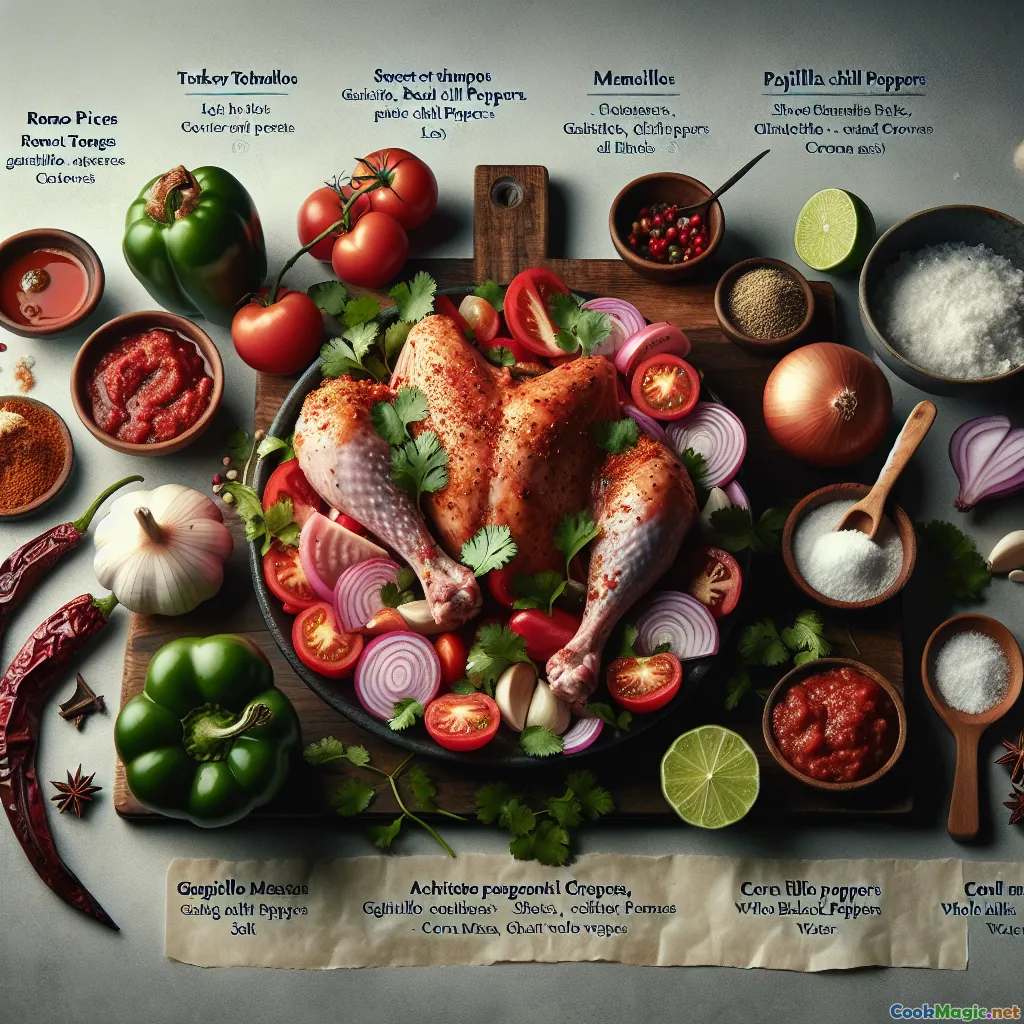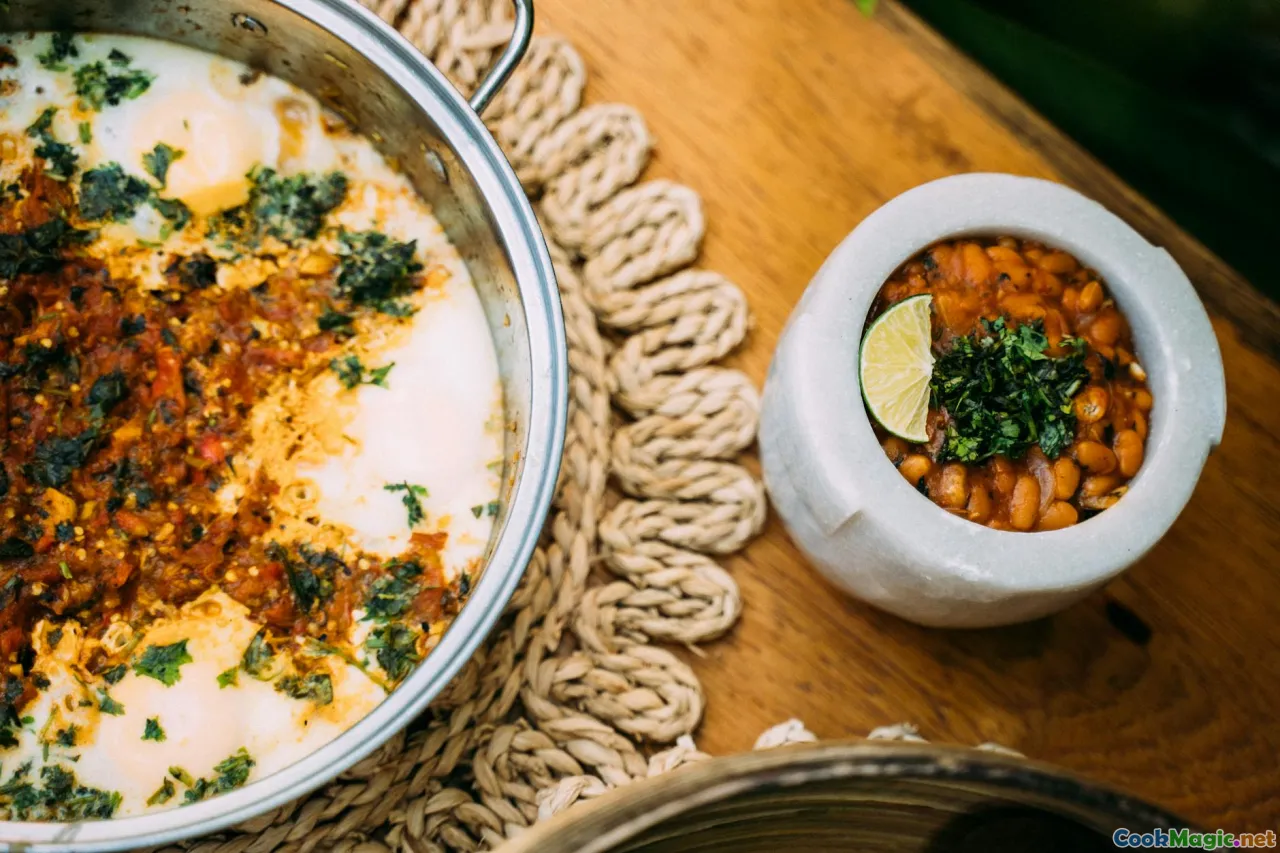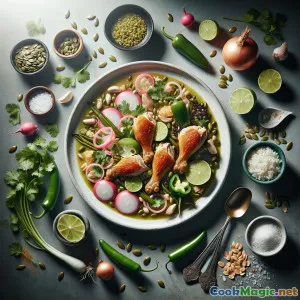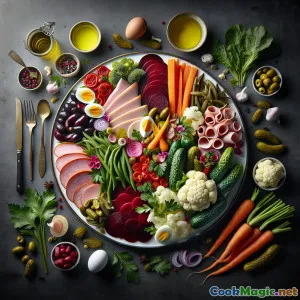
スモーキーなカク’ikスープ:グアテマラのスパイシーなターキースタew
(Smoky Kak'ik Soup: Guatemala's Spicy Turkey Stew)
(0 レビュー)材料
-
1.2 kg ターキーの切り身(腿、もも、翼)
(皮付きまたは丸ごと小さなターキーの切り身、下処理済み)
-
4 medium ローマトマト
(新鮮で熟した)
-
3 medium トマティーヨ
(皮をむいて洗った)
-
1 large スイートレッドペッパー
(粗く刻む)
-
2 tbsp アチョテペースト
(深い色合いと土のような風味のために)
-
2 whole ワハイロ・チリペッパー
(種と茎を取り除いた)
-
1 whole パシージャチリペッパー
(種と茎を取り除いた)
-
6 whole ニンニクの cloves
(皮をむいた)
-
1 large ホワイトオニオン
(刻んだ)
-
1 bunch コリアンダー
(飾り用に葉をいくつか取っておく)
-
1 small handful ミント
(できれば地元の『ハエルバ・ブエナ』)
-
5 pieces ホールオールスパイスの実
(オプション、温かみのあるノートを追加)
-
4 tbsp コーンマサ
(とろみ付けやコーンミールの代替として)
-
6 pieces ライムのくし切り
(提供用)
-
2 tsp 塩
(お好みで)
-
1 tsp ブラックペッパー全粒
(新鮮に割った)
-
2.5 liters 水
(自家製ターキーチキンストック(利用可能な場合))
(皮付きまたは丸ごと小さなターキーの切り身、下処理済み)
(新鮮で熟した)
(皮をむいて洗った)
(粗く刻む)
(深い色合いと土のような風味のために)
(種と茎を取り除いた)
(種と茎を取り除いた)
(皮をむいた)
(刻んだ)
(飾り用に葉をいくつか取っておく)
(できれば地元の『ハエルバ・ブエナ』)
(オプション、温かみのあるノートを追加)
(とろみ付けやコーンミールの代替として)
(提供用)
(お好みで)
(新鮮に割った)
(自家製ターキーチキンストック(利用可能な場合))
栄養
- 分量: 6
- 1人分の量: 大きなボウル(約350ml)
- Calories: 450 kcal
- Carbohydrates: 0 g
- Protein: 57 g
- Fat: 15 g
- Fiber: 6 g
- Sugar: 7 g
- Sodium: 780 mg
- Cholesterol: 125 mg
- Calcium: 78 mg
- Iron: 3.2 mg
作り方
-
1 - 唐辛子と野菜の準備:
フアヒージョとパシージョチリを、熱く乾いたスキレット(コマル)で軽く焼き、香りが出るまで、しかし焦がさないようにします。火から下ろし、温水に10分間浸して柔らかくします。
-
2 - 香り付け用の香味野菜:
同じ熱いフライパンで、トマト、トマティージョ、ニンニク、玉ねぎ、ピーマンをよく焦げ目がついて少し黒くなるまで焼き、均一にローストされるように必要に応じてひっくり返します。火から下ろして脇に置きます。
-
3 - ベースをブレンドする:
ブレンダーで、柔らかくした唐辛子、焼き焦げた野菜、アチオテペースト、黒胡椒、オールスパイス(使用する場合)、および1カップの水を混ぜます。非常に滑らかで濃厚なペーストになるまでブレンドしてください。
-
4 - ターキーを焼き色がつくまで炒める:
大きな厚手の鍋に少量の油を熱します。七面鳥のかたまりをすべての面で色づくまで焼き、濃厚な味わいを引き出します。必要に応じて余分な脂肪を取り除きます。
-
5 - ターキーを煮込む:
ブレンドしたチリペーストをターキーの鍋に加えます。残りの水(またはストック)を注ぎます。塩を加えます。沸騰させて火を弱め、蓋をして60分間煮込みます。ターキーが柔らかくなり、スープに濃い色がつくまで調理します。
-
6 - ハーブと生地を追加:
トウモロコシの粉を少しのブロスと混ぜて滑らかなペーストを作ります。コリアンダー(シラントロ)、ミント、そしてマサの混合物をスープに加えます。弱火でさらに10分煮込み、軽くとろみをつけて香りを浸透させます。
-
7 - 飾り付けと提供:
塩味を確認し、必要に応じて調整してください。スープを熱いうちに大きな器に盛り、それぞれにたっぷりのターキー、たっぷりのブロス、新鮮なコリアンダーとライムのくさびを添えて絞ってお召し上がりください。
フアヒージョとパシージョチリを、熱く乾いたスキレット(コマル)で軽く焼き、香りが出るまで、しかし焦がさないようにします。火から下ろし、温水に10分間浸して柔らかくします。
同じ熱いフライパンで、トマト、トマティージョ、ニンニク、玉ねぎ、ピーマンをよく焦げ目がついて少し黒くなるまで焼き、均一にローストされるように必要に応じてひっくり返します。火から下ろして脇に置きます。
ブレンダーで、柔らかくした唐辛子、焼き焦げた野菜、アチオテペースト、黒胡椒、オールスパイス(使用する場合)、および1カップの水を混ぜます。非常に滑らかで濃厚なペーストになるまでブレンドしてください。
大きな厚手の鍋に少量の油を熱します。七面鳥のかたまりをすべての面で色づくまで焼き、濃厚な味わいを引き出します。必要に応じて余分な脂肪を取り除きます。
ブレンドしたチリペーストをターキーの鍋に加えます。残りの水(またはストック)を注ぎます。塩を加えます。沸騰させて火を弱め、蓋をして60分間煮込みます。ターキーが柔らかくなり、スープに濃い色がつくまで調理します。
トウモロコシの粉を少しのブロスと混ぜて滑らかなペーストを作ります。コリアンダー(シラントロ)、ミント、そしてマサの混合物をスープに加えます。弱火でさらに10分煮込み、軽くとろみをつけて香りを浸透させます。
塩味を確認し、必要に応じて調整してください。スープを熱いうちに大きな器に盛り、それぞれにたっぷりのターキー、たっぷりのブロス、新鮮なコリアンダーとライムのくさびを添えて絞ってお召し上がりください。
スモーキーなカク’ikスープ:グアテマラのスパイシーなターキースタew :の詳細
Kak'ik de Quetzaltenango: A Fiery, Aromatic Classic from the Guatemalan Highlands
Kak'ik is one of the jewels of Guatemalan cuisine, perched proudly on tables during family celebrations and festive occasions in the country’s western highlands, especially around Quetzaltenango (also called Xela). At first glance, it appears to be a simple “turkey stew,” but unpacking a single bowl reveals the rich history, vibrant ingredients, and stubborn Mayan traditions that have survived centuries of change.
Historical & Cultural Significance
Kak'ik (pronounced kahk-eek) traces its roots to the ancient Mayan people, who settled in Guatemala well before the Spanish conquest. The name itself derives from the Q’eqchi’ Mayan language: 'kak' meaning “red” and 'ik' meaning “hot, or spicy.” Although now spread across many regions, it remains particularly meaningful in Quetzaltenango, where indigenous Cakchiquel and Mam communities craft their brothy staple much as their ancestors once did—wood-fire, clay pots, and all.
Traditionally, Kak’ik uses wild turkey or 'chompipe,' an animal with deep ritual and culinary value. The bright scarlet color, imparted by heaps of luscious ripe tomatoes, annatto (achiote), and chilis, recalls strength and sacrifice.
What Makes This Version Unique?
- Layered Smokiness: Step one is the subtle toasting and charring of chilis and vegetables, a classic Mayan technique lending unparalleled depth.
- Aromatic Thickeners: By swirling masa (corn dough) in at the end, the broth gains a pleasing, silky body, echoing Guatemalan tortillas. This version uses fresh cilantro and native mint—bold and fragrant.
- Rustic Presentation: Each bowl boasts a meaty turkey chunk surrounded by a sunset-red broth, sometimes eaten with 'tamales de masa' or simple white rice on the side.
Substitutes, Serving, and Tips
- Use chicken if turkey is unavailable, but the wilder gaminess of turkey is more traditional and flavorful.
- Toltec and Mayan recipes use native 'hierba santa' instead of mint—seek it out for a truly authentic fragrance.
- Adjust chili quantity for a milder or feistier soup.
- Leftovers can be refrigerated up to 3 days; flavors deepen substantially overnight.
Perfect Pairings
Guatemalan corn tortillas or a classic rice side (‘arroz blanco’) turn Kak’ik into a hearty main. For festivals, locals pour it into large bowls and gather family together—every bite is connective, memorable.
Personal Thoughts
Cooking Kak'ik is like traveling in both time and place. The scents—spicy, smoky, and green—waft through the kitchen, teaching patience and respect for Maya culinary ritual. Many Guatemalan cooks say, “A soup isn’t ready until it’s shared.”
So treat Kak'ik de Quetzaltenango as more than a weekend culinary project; see it as a stew layered with history, community, and flavor. Whether you're seeking warmth, a taste of Central America, or the magic of Mayan food technology, this recipe is your gateway to a singular, spicy tradition.
























